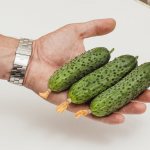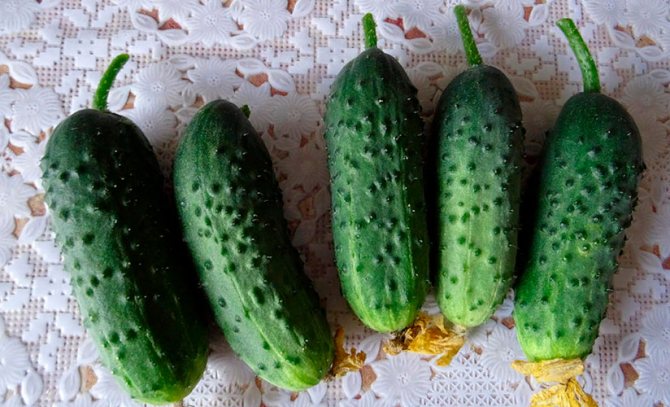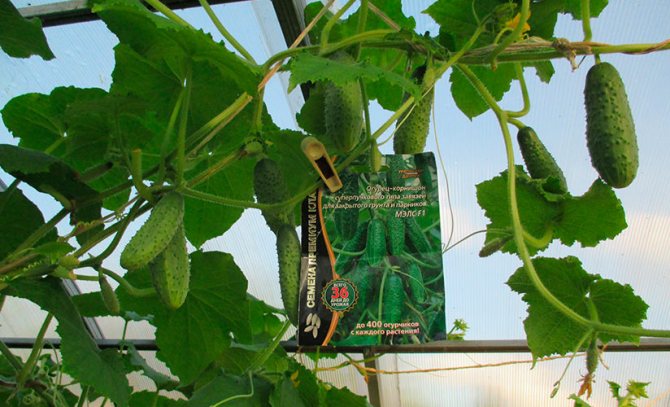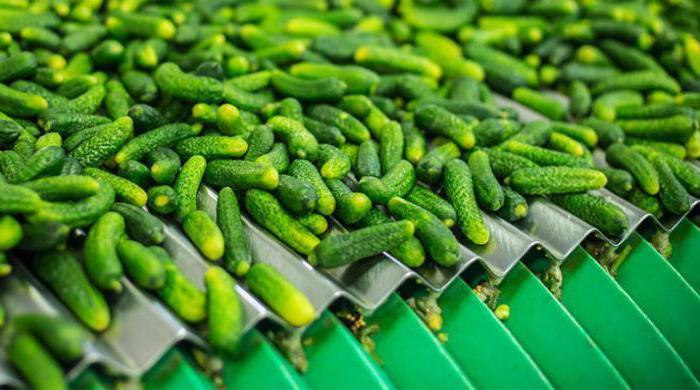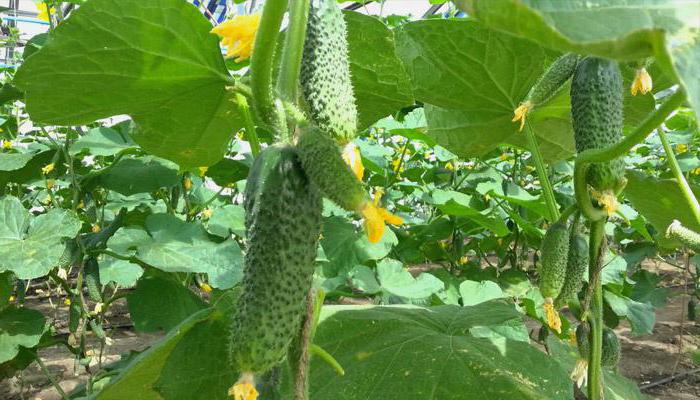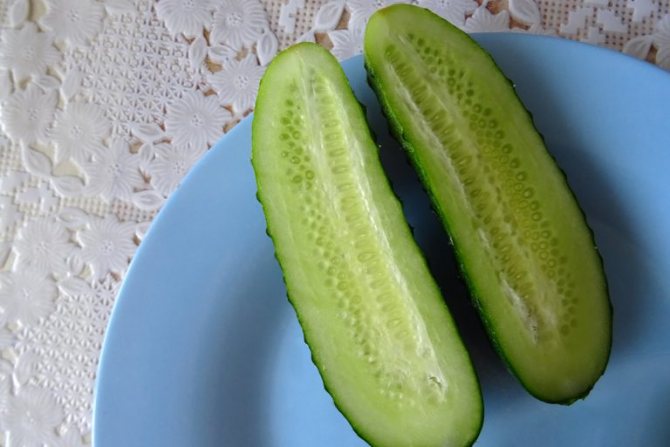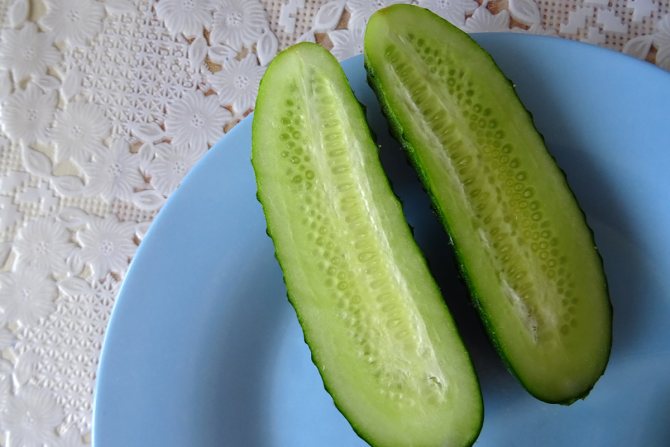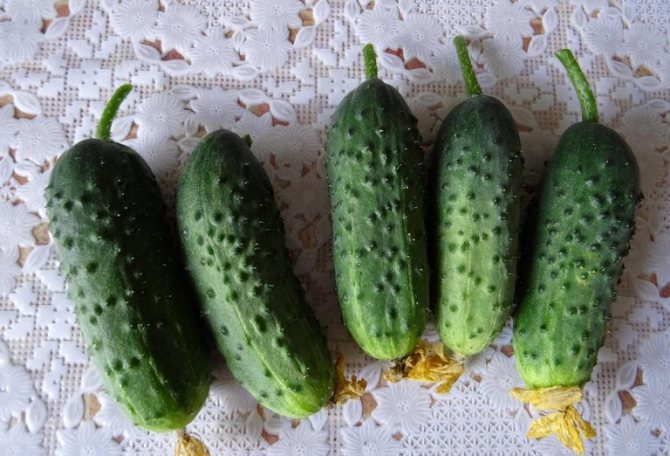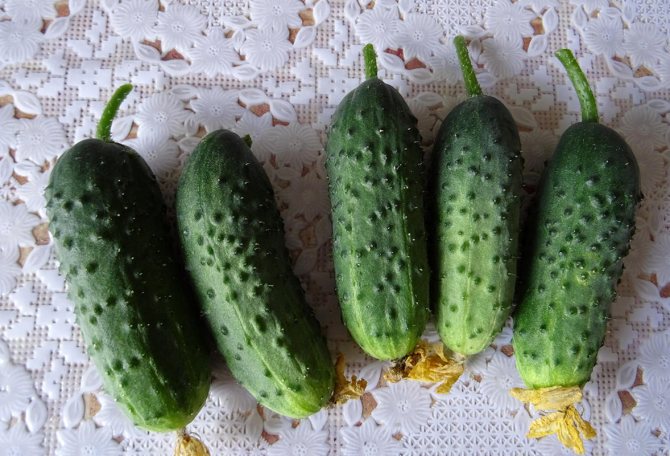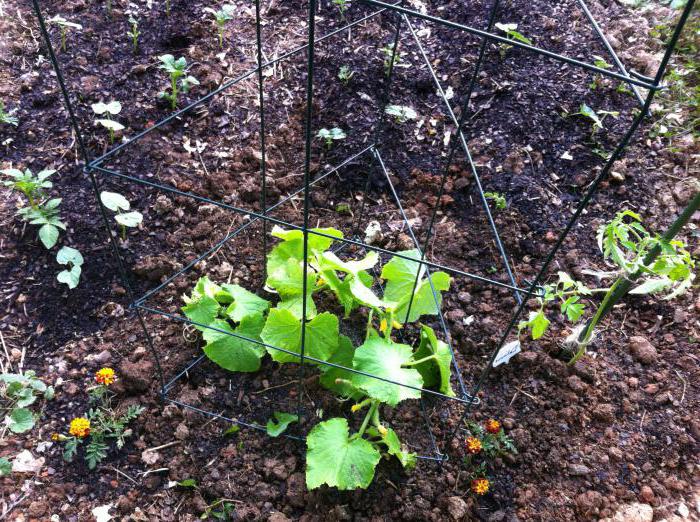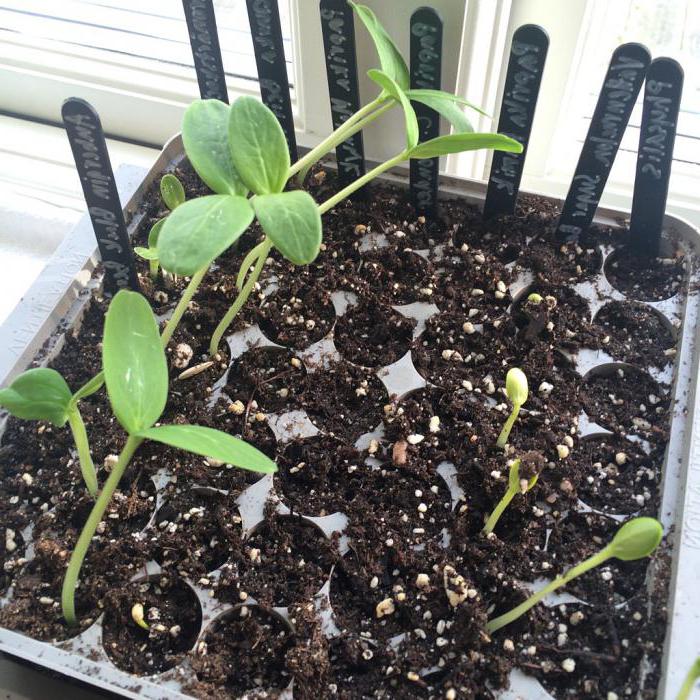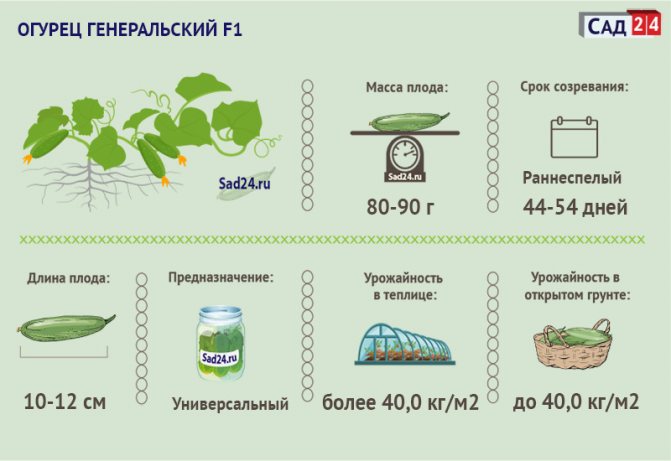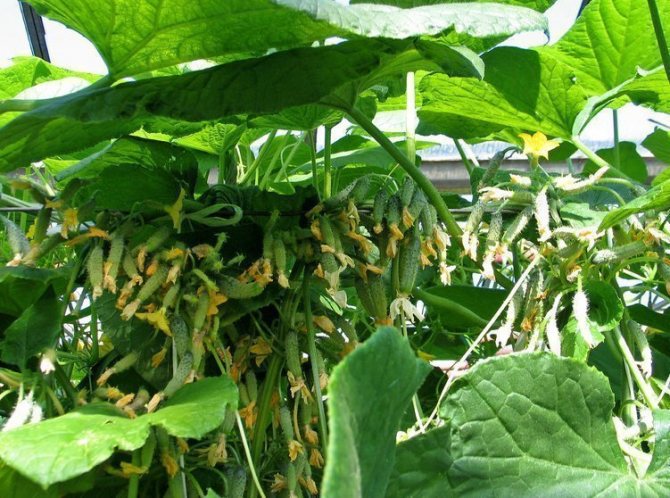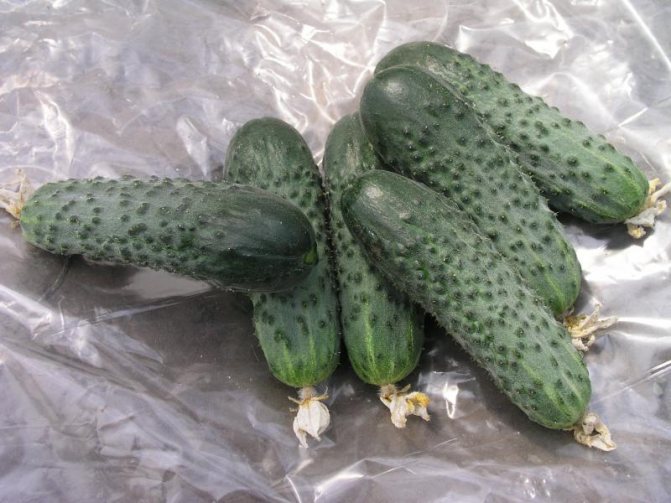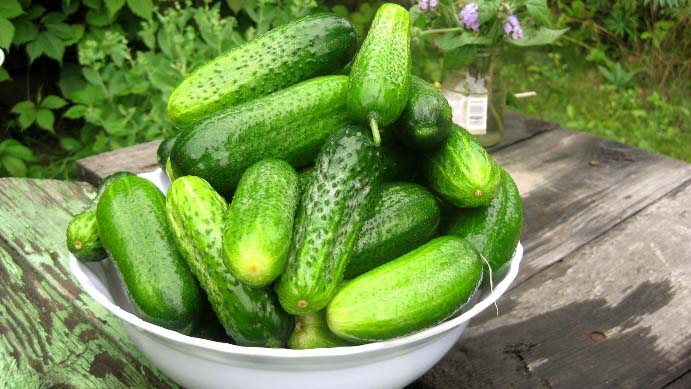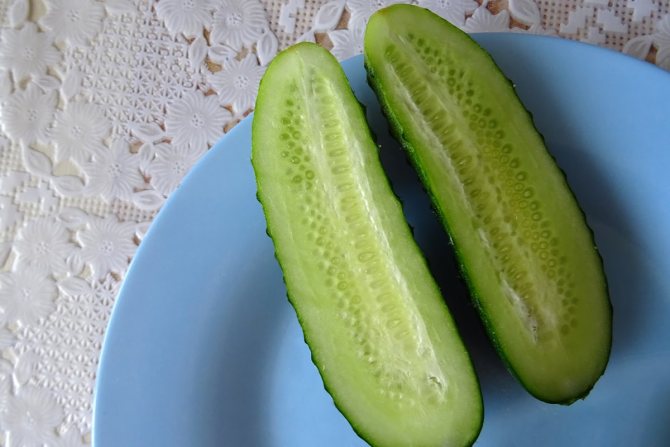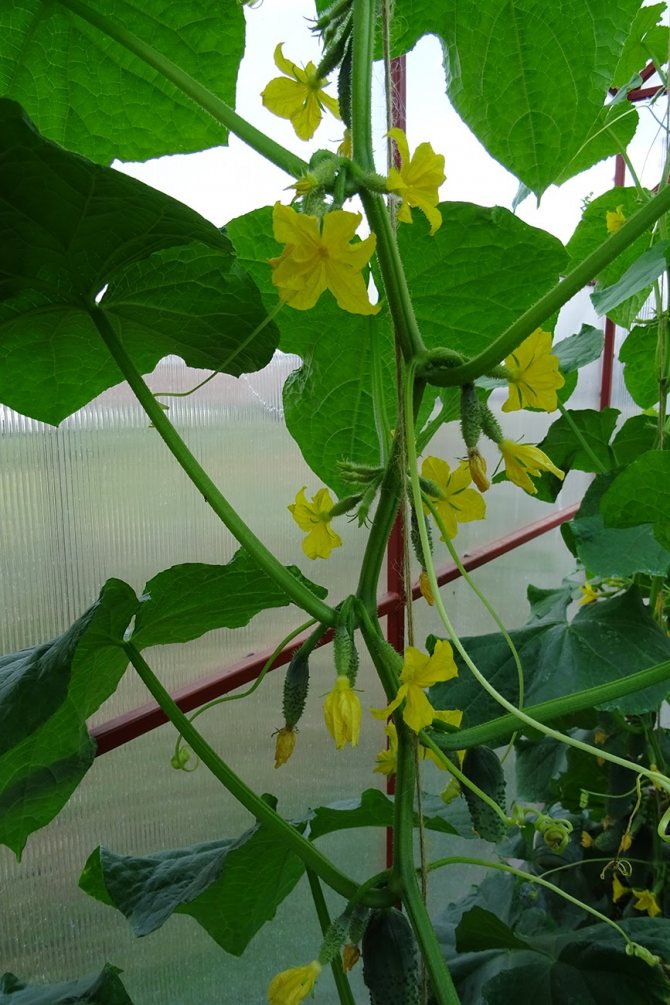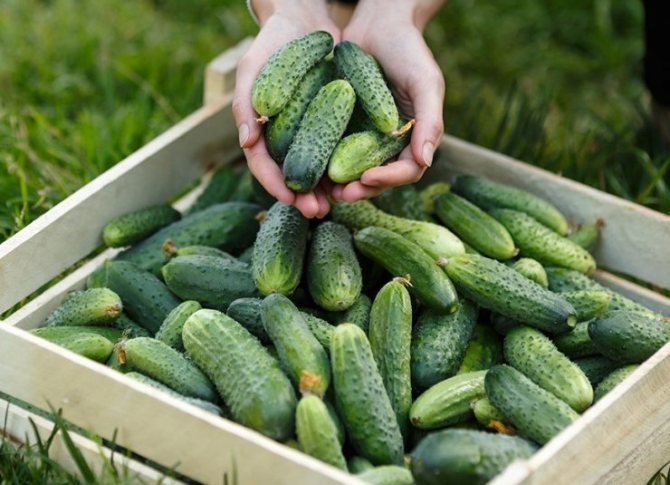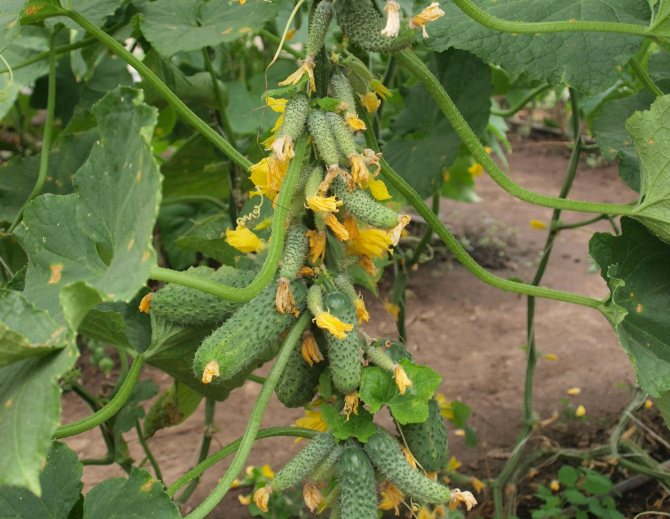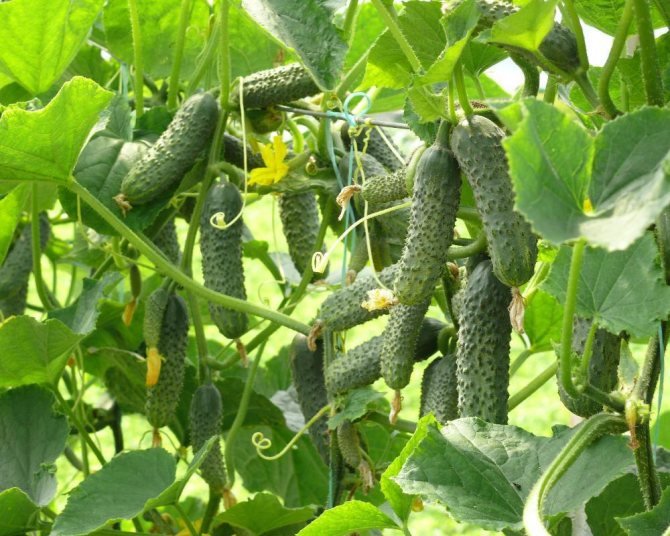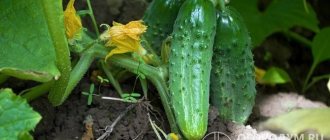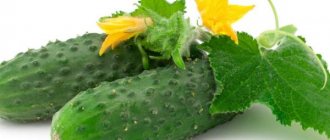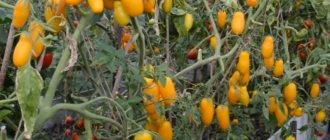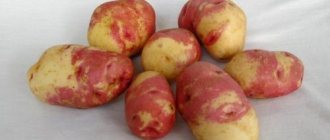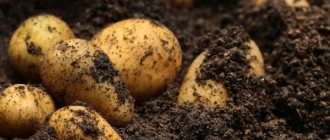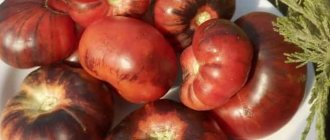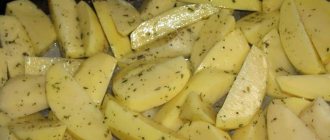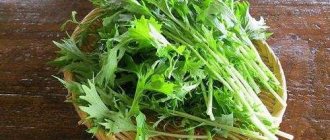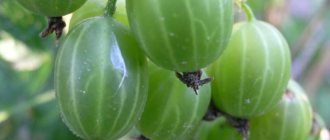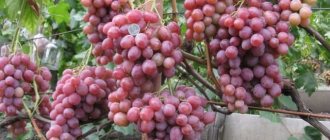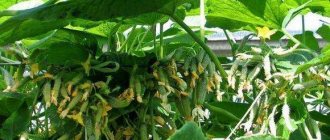The variety will delight you with an excellent harvest. There will be enough fruits from one garden for the whole family to eat and harvest, and there will still be enough to treat the neighbors. Zelentsy crunchy deliciously, have a pronounced appetizing smell.
| Pick-up location | Ripening terms | Mode of application | Fruit length | Group | Fruit smoothness | Pollination method |
| Universal | Early ripe (35-45 days) | Universal | Medium - from 10 to 15 cm | Hybrid | Heavily hilly | Parthenocarpic |
Description of the variety
Main characteristics:
- Ripening period: Early maturing;
- Grade: Hybrid;
- Productivity: up to 40 kg / m2;
- Fruit color: Dark green;
- Others: Collection Superbeam cucumber hybrids;
- Type of packaging: Colored bag;
- Packing: 5 pcs.;
- Pollination type: Parthenocarpic;
A new direction in the selection of superbeam (there can be many ovaries in bunches - up to 10-12) cucumber - the creation of hybrids with a self-regulating type of branching - when a high crop load on the main stem does not allow lateral shoots to form quickly. Later, when most of the crop is harvested from the main stem, the side shoots will begin to grow faster.
Thus, in the presence of self-regulation of branching, much less time is spent on pinching the lateral shoots. This is especially important if you come to the garden only on weekends - such plants do not have time to overgrow too much during the working week.
Good branching is a guarantee of long-term active fruiting (i.e., the more a cucumber branches, the longer the potential yield period). Generalsky F1 - One of the most highly productive, ultra-early superbeam hybrids-parthenocarpics.
It is famous for the excellent formation of lateral shoots and the "bouquet" type of ovary, in one leaf sinus up to 12 such ovaries can form, from which then cute, neat and small dark green gherkins 10-12 cm long with amazing crispy, fragrant pulp mature. The taste and salting qualities of cucumbers are simply excellent.
A predominantly female flowering plant, it grows excellently both outdoors and in greenhouses. Fruiting until autumn, resistant to lack of heat and light and many diseases of the cucumber. Also, the variety is very convenient for those who can only harvest on weekends, the plant does not have time to overgrow too much, and the fruits do not overripe.
Appearance
The plant is vigorous (height may exceed 2 m), climbing. A feature of this hybrid is the self-regulating type of branching. This means that, with a large yield load on the main stem, lateral shoots are not formed or are formed very weakly.
They begin to grow actively as soon as the bulk of the crop is harvested. Up to 12 ovaries are formed in the nodes. Such cultures are called superbeam. Cucumbers are very attractive - small (10 - 12 cm long), dense, neat, dark green in color.
The surface is bumpy to the touch. The tubercles are large, medium or frequent. The pulp of the greens is crispy, aromatic.
Features and characteristics
General'skiy has a high yieldDuring the growing season, you can collect up to 40 kg per square meter, and in the greenhouse this figure will be even higher.
- Up to 400 delicious fruits are removed from one plant per season;
- the first greens ripen in June (if planted with seedlings), but due to cold resistance, fruiting lasts a very long time - in the open field until mid-autumn.
- In a greenhouse, this process is even longer; cucumbers do not ripen one by one, but several pieces at once;
- incredible shade tolerance is a significant plus.
- And in combination with cold resistance, it makes the variety an excellent option for cool regions where the sunny day is short;
- hybridity provides genetic protection against almost all diseases;
- the use of Generalskoe fruit is universal. They are good fresh, great for pickling and canning.
Agrotechnics
Cucumbers are grown either through seedlings or directly sown seeds in the ground. To obtain seedlings, the seeds are planted in seedling pots, to a depth of about 1.5-2 cm and grown at a temperature of about 25 ° C. After the shoots appear, the temperature is lowered to 15 ° C.
Remember that you can transplant seedlings into the ground only when you are completely sure that there is no negative temperature at night, and the soil warms up to no less than 9-13 ° C.
The same requirements for soil temperature apply when directly planting seeds in the soil. At the same time, the planting depth increases to 2-3 cm. Sowings of cucumbers on the ground should be covered with special materials, a wide selection of which we also present in the 7 Hectare store, it can be a special film or agrofibre.
During the growing season, to obtain a high yield, usually up to three dressings are carried out; you can select the necessary fertilizers in the appropriate section. For pest control, appropriate preparations are used. The crop is harvested as it ripens, it depends on the specific variety and climatic conditions.
rules
- It was recommended to form it strictly into one trunk - everything shaped it as well.
- Plant less often - I left 70 cm between the super-bunched cucumbers.
- To dazzle the first 4 sinuses - I did just that.
- Feed vigorously - it grows on manure, and I feed it a little more at the root, for example, with infusion with goat bedding (it doesn't stink at all!)
- Drink abundantly - in the heat every evening or morning, if you don't have time. And in the rain every other day, the usual rate of 4 liters per bush (half a watering can).
- Remove cucumbers in a timely manner. It is General's F1 that is tastier and more beautiful with gherkins, if it outgrows it, though tasty, but so inside, unglamorous.
Soil for the variety
The acidity level of the soil is very important for the general's cucumber. You can check it with ordinary table vinegar. This is done as follows: a handful of earth is poured into a glass container. It must be poured with vinegar. Alkaline soil will react violently with hiss and bubbles. A weak chemical reaction indicates the neutrality of the soil, but its absence indicates a high level of acidity.
For the results of the experiment to be accurate, it must be carried out in glass or earthenware, but not in any case in iron. This can give a false result. This study is carried out in the fall, because the process of deoxidizing the earth takes time. As soon as the last crop is harvested and the plots are harvested, soil analysis is carried out.
Correction of soil acidity
To reduce this indicator, lime is introduced into the soil, which extinguishes acid. The procedure is performed every 2-3 years, more often it is not necessary. In the process, you can use the following substances that contain the desired element:
- A piece of chalk.
- Slaked lime.
- Dolomite flour.
- Wood ash.
As winter approaches, the soil is dug up and sprinkled with a thin layer of the above substances. After that, they are carefully raked over the ground in order to distribute acid absorbers in it.
Method for determining soil moisture
The study of the land according to this criterion is not difficult at all. Since the roots of the "Generalsky" variety are small, they are located in the upper layers of the soil. Therefore, they need to be considered. It is necessary to dig a hole no more than 5-7 cm deep. Taking the earth in your hands, it is easy to determine whether it is wet or not. If the soil is dry, then, of course, you will need to pay more attention to it.
Lack of moisture should not be tolerated even at this depth. The cucumber has very delicate roots that easily deteriorate due to over-dried soil and its overheating. That is why experienced gardeners recommend mulching the soil for this vegetable.
Mulch can be made from the following materials:
- Compost.
- Not coarsely chopped straw.
- Wood sawdust.
- Peat.
Such mulch has a good effect on the characteristics of the soil, because the activity of beneficial bacteria is activated in it. After all, it not only saturates the earth with carbon dioxide, but also eliminates the moisture deficit.
Testimonials
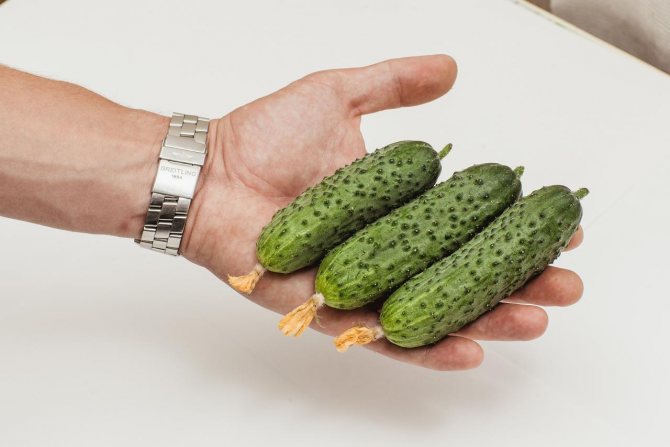
Anastasia
Previously, I grew only gherkin cucumbers, now I have completely switched to medium-sized ones, they look attractive in cans, and salad hybrids have a richer taste. On my list of favorites, Hercules and Athena, I grow the first variety for summer cuts, and the second for winter preparations. Both hybrids do not tolerate shade and do not grow in places with high groundwater levels, are equally susceptible to aphid damage. During the season, I regularly spray the bushes with infusions of celandine, bitter pepper, as well as biological products - Fitoverm, Strela, Biotlin.
Egor
I live in the Krasnodar Territory, I visit my country house only on weekends, so growing cucumbers is a problem for me, few varieties are able to develop normally in heat and drought. The hybrid became a godsend for me, 5 days without watering, but with a thick layer of mulch it tolerates without problems, continues to set fruits well. The yield is really high, but only if the bush is not overloaded with lashes, I form it into 1-3 stems, be sure to cut off the old leaves. I feed it once every 2 weeks, before flowering with nitrogen fertilizers, and after the appearance of ovaries - with phosphorus-potassium or organic matter.
Cucumber "General f1" - reviews, photos and opinions of amateurs and gardeners
- Kristina:
The bushes are very tall and climbing, for normal cultivation, the construction of trellises and the formation of a bush into one stem are required. The pulp is medium firm, but crispy and very juicy. The beds look very unusual, 10-12 ovaries are formed in one node. With such abundant fruiting, high-quality frequent feeding with a mixture of organic matter and mineral fertilizers is necessary. Only in this way are the bushes formed strong, capable of withstanding the weight of the crop, and the cucumbers themselves do not shrink, the taste characteristics do not deteriorate.If we use the seedling method of growing, then the 1st crop can be removed in June. Fruiting in the open field lasts until mid-autumn, in the greenhouse it is much longer. The variety is resistant to cold weather and temperature extremes. A bad summer does not affect the productivity and quality characteristics of the fruit.
"Generalsky" grows well in the Vologda region without the use of high agricultural technologies. There is genetic immunity to most "cucumber" diseases (it is possible to do without a large amount of chemistry for protection and get an ecologically clean crop), genetically there is no bitterness. For pollination, insects are not required, barren flowers are not found.
- Tatiana: I expected super ovaries from this variety, but I never got 10 cucumbers in bunches. Grown in a greenhouse, planted the sprouts a month after germination. I have been growing cucumbers for more than 15 years, I know agricultural technology. I immediately tied up the vine, but it began to actively grow somewhere in mid-June.
Cucumbers set early, bloomed well, but there were barren flowers. As a result, only 3-4 cucumbers in a bunch. The liana was shaped the way many F1s are usually formed for greenhouses: it blinded the lower flowers and stepchildren at the first 3-4 leaves.Fed with organic matter, mullein infusion. Fruiting little by little and for a long time, until September. - Victoria: It is not for nothing that the producers gave such a name - a good variety! I bought the seeds, because they are from our Ural producer, the selection is also from the Ural Dachnik agrofirm. She planted seedlings in a greenhouse, 2 pieces per meter. There is little space in the greenhouse, the rest of the sprouts were placed on a high bed, covered with non-woven material, under the arches.
The liana grew up to a height of more than 2 meters, pinched it and removed the lower shoots in the sinuses. Cucumbers are tied in bundles, 8-12 pieces each! But abundant feeding is needed. I not only fertilized the soil, but after spilling it, I poured half a bucket of compost under each bush. In the open ground, the liana curled in my garden, also in one stem: I poured a lot of mulch so that the cucumbers did not come into contact with the ground, as well as compost and ash for fruits.The harvest was also abundant. In the greenhouse 2-3 weeks earlier. This is a good indicator for our region. Cucumbers were harvested until autumn, fruiting did not end in any way! They proved to be resistant to cold and heat, even drought. They did not suffer from any cucumber diseases. I did not see any pests either. Cucumbers are small (10 cm), tasty and crunchy, good for pickling and fresh consumption.
Declared and identified advantages, disadvantages
Cucumber Mels F1 has the following advantages:
- Pollinated without the participation of insects.
- Has outstanding productivity characteristics.
- The fruits can be used both for salads and for long-stored preparations.
- The cucumber is ultra-early ripening.
- The culture is inoculated with immunity from the most destructive diseases.
- The vegetable retains its quality indicators during transportation.
Reported disadvantages:
- the hybrid cannot be propagated by its own seeds;
- a cucumber is sensitive to a sharp cold snap;
- attention must be paid to the formation of the stem.
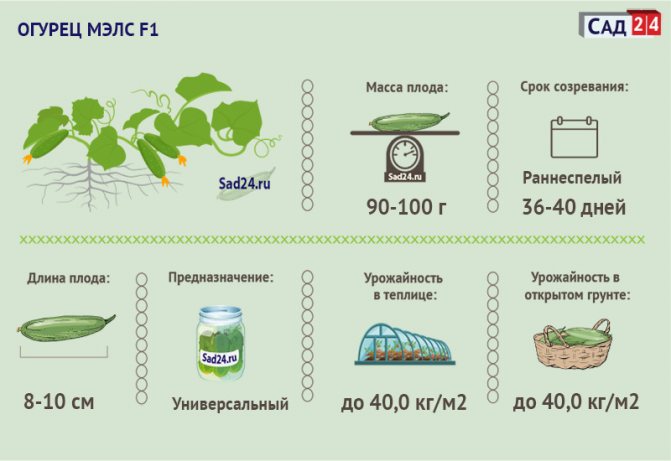

Features of cold-resistant cucumbers
Most of these cucumbers are first-generation hybrids produced with the F1 label. The thing is that it was possible to obtain plants with unique characteristics only in the course of painstaking breeding work, but on the other hand, the results are simply excellent.
Hybrids grow well and bear fruit in a variable climate, frequent precipitation, cold winds. They are not afraid of cold snaps, temperature drops, shading. They are unpretentious in care, but with proper agricultural technology and top dressing, the yield will be higher.
It is recommended to grow all the listed hybrids through seedlings. The review presents cucumbers used for salads, canning, pickling, and also for universal purposes. The choice is large: both in terms of fruit ripening, and in external parameters (shape, length of zelents), and in the characteristics of the hybrid (bee-pollinated, parthenocarpic).
They are grown on open-air ridges, under shelters, in greenhouses. But due to their endurance and cold resistance, almost all hybrids give excellent harvests in the beds. Website about the cottage
Benefits
Bunch cucumbers of a hybrid species have many advantages, thanks to which they are very popular:
- Resistant to damage from various diseases.
- Tufted cucumbers are not afraid of temperature changes.
- They have early ripening periods.
- They are characterized by high productivity.
- They have excellent taste.
Few varieties of vegetables of this kind can match the vitality of hybrids. They are distinguished by their fast growth, endurance. In a lean year for other crops, cucumbers bear fruit abundantly. This is due to the fact that the best qualities are inherited by them.
Landing
There are two ways to grow cucumbers: seedling and seedling. It will be about the first method. Using this method, it must be remembered that the timing of sowing seeds begins at the end of May and ends on 5 June.Before sowing seeds, they need to be warmed up for two hours at a temperature of 60 ° C.
This must be done in order for the heated seeds to give good shoots and also bear fruit earlier. After that, they need to be placed in a solution that consists of 1 liter of water, 5 g of double superphosphate, 10-potassium nitrate and 0.2 g of manganese sulfate. Then the seeds that have swollen must be sown, mixing with dry ones.
This action provides an early harvest, as if the early seedlings die, then they are replaced by late ones, which are obtained from dry seeds. Further, each seed must be placed in the grooves so that it is located at a distance of 3-4 cm. The grooves must be made at a distance of half a meter from each other. Usually half a gram of seeds is consumed per 1 square meter.
The depth of their seeding should be 1-2 cm. In case of drying out of the soil, it is imperative to water the grooves and only then sow the seeds into moist soil. Then it is necessary to close the top with loose soil, humus with sawdust or peat.
It is very important to monitor the emergence of seedlings as closely as possible, as if there are nests of rooks or other birds nearby, then young, not yet rooted plants are in danger. To scare away birds, you can install a stuffed animal, rotating rattles, hang rustling paper or strips of film.
After the seedlings have appeared, it is necessary to monitor the level of soil moisture, as well as the condition of the plants. In the evening, you need to water the plants with water, the temperature of which is approximately 20-25 ° C, with a ratio of 1.5-2 liters per 1 square meter, if the leaves become sluggish during the day and with a weak turgor.
If the plants close, then the seedlings usually need to be thinned 2-3 times, given that each time only the weakest should be removed. The planting scheme is as follows: the distance in the row between the plants must be left from 5 to 15 cm. Thinning of plants can be combined with such procedures as weeding and loosening.
When the plants grow to half the distance between the rows, then loosening must be stopped so that there is no risk of damage to the roots. The growing plants should then be spread evenly over the soil surface.
Pests and diseases
Variety Mels f1 is resistant to the main diseases of cucumbers (powdery mosaic virus, olive spot, powdery mildew, etc.). In order to secure the harvest, simple measures are taken to prevent them: regular ventilation of the greenhouse, control of humidity; if the greenhouse is glass, you need to periodically wash the glass with a cloth soaked in a soapy solution with a small alkali content.
Diseases
A simple recipe for a solution of brilliant green and water will save from root rot.
For 5 liters of water, it is necessary to dilute 10 drops of brilliant green and water the plant. If powdery mildew has overcome the leaves of the cucumber, then a solution of water, low-fat milk and iodine will save: 10 drops of iodine and 1 liter of low-fat milk are diluted with 9 liters of water. The resulting mixture is treated with the affected areas of the plant.
Pests
The most common pests are: whitefly, sprout fly, spider mite, melon aphids.
Preventive measures must be taken even before sowing seeds. In March-April, after the snow melts, you can smoke the greenhouse with sulfur bombs (0.05 kg per m³). Disinsection of the soil can be carried out with carbation (2%), the product is sold in gardening stores. It is poured over the entire sown area (5 liters per m²). It is better to carry out disinfection 30-45 days before sowing the soil with seedlings or seeds.
Cucumber care
Caring for cucumbers includes pinching or pinching (pinching), weeding, watering, feeding and garters on trellises.
Pickling or pinching cucumbers
All stepchildren (ovaries and even lateral shoots) growing from the first 3 or 4 leaves of a young cucumber plant should be removed.This will help the cucumber develop a healthy and strong root system.
When growing varietal cucumbers (especially late-ripening ones), pinching of the main stem is required after the 5-7th leaf. The fact is that the old varieties produce only male flowers on the main stem and pinching stimulates the development of lateral stems with female flowers.
Old hybrid cucumbers usually branch well without pinching the top of the stem. The top of the main stem of such cucumbers can be pinched only if, for some reason (too fresh seeds, bad weather conditions, etc.), independent branching is delayed, and only male flowers appear on the main stem.
Some experts also recommend pinching all lateral branches of old cucumber hybrids after the second ovary, but others strongly discourage this. Apparently, every gardener should be guided by the situation.
Modern cucumber hybrids already produce only female flowers on the main stem, and do not produce side shoots at all. Of course, pinching the stem of such cucumbers is not required, they actively bear fruit on it.
How to distinguish a female from a male cucumber flower? An ovary (miniature cucumber) is already present in the female flower. For self-pollinated varieties, the presence of male flowers on the plant is important, so you should not completely remove the male cucumber flowers so as not to be left without a crop.
Cucumbers grown in the greenhouse need pruning more, because their growth rate and plant size are much larger than those grown in the open field.
Watering and feeding cucumber
Air humidity and watering are especially important for cucumbers during active growth (June) and fruit formation (July, August). Even a short-term drying out of the soil during fruit formation leads to the appearance of bitterness in cucumbers, which then cannot be eliminated by any watering. Cucumbers should be watered with warm water (cold water leads to growth inhibition and gray rot).
To preserve soil moisture, planting cucumbers is mulched with organic materials (you can even use cut grass from the lawn). Mulch protects the soil from drying out quickly and suppresses the growth of weeds, which means that you can water the cucumbers less often, and you will not have to loosen and weed the garden bed.
The root system of cucumbers needs air. Frequent watering compacts unmulched soil, and loosening damages the delicate roots. To provide air access, using garden forks, punctures are made in the ground to a depth of 10-15 cm.
When feeding cucumbers, to avoid burns, water the moistened soil around the plants with a fertilizer solution, avoiding contact with the foliage. In cold, cloudy weather, the growth of cucumbers slows down and the roots of the cucumbers cannot actively absorb nutrients. Therefore, you should not fertilize cucumbers in such conditions.
Regular, frequent harvest of cucumbers promotes more abundant fruit production, slowing down the aging of the plant and increasing yields. Cucumbers of short-fruited varieties are harvested every 1-2 days, long-fruited (greenhouse) - every 3-4 days.
Preventing problems when growing cucumbers
When growing cucumbers in the open field during prolonged rains, there is a danger of the rapid spread of gray rot in thickened lashes of plants. Good results are obtained by tying cucumbers on trellises: meter-long strong stakes are driven into the ground, a rope is pulled between them and cucumber lashes are tied up (like vineyards).
Sometimes, only male flowers are formed in the planted cucumber seedlings. To stimulate the formation of flowers with ovaries, you should stop watering the cucumbers for several days, allowing the soil to dry out.
Yellowing and dropping of cucumber ovaries indicates waterlogging of the soil or a deficiency of nutrients, which can occur with a thickened planting. In such a situation, it is necessary to let the soil dry out and then feed the cucumbers with a solution of mineral fertilizers or ash.
You should be careful about feeding cucumbers with organic substances: liquid solutions of organic matter can contain pathogens of fusarium, and solutions based on infusion of weeds can carry viruses of various diseases (for example, the tobacco mosaic virus remains viable for almost a year).
Cucumber X 90 f1
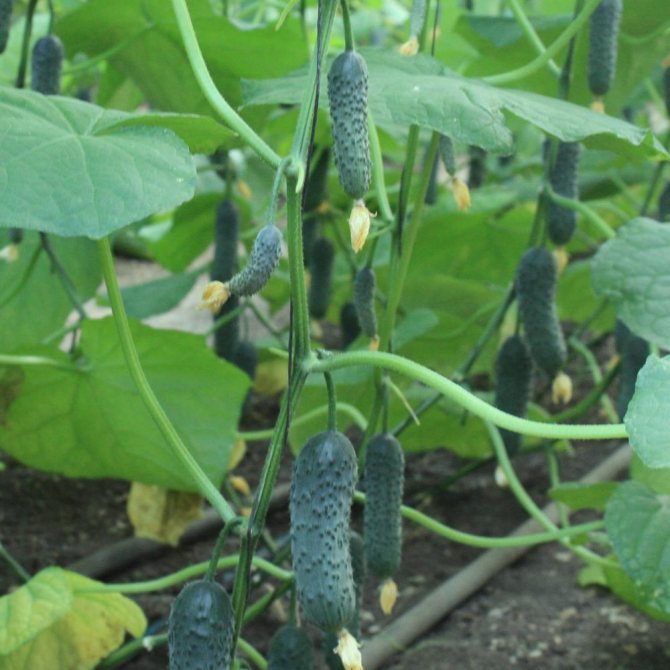

A hybrid from the Japanese agricultural firm Kitano, popular in all regions of Russia. Cucumbers ripen early. The bush is indeterminate, powerful, gives a large number of lateral lashes, while there are many ovaries (2–5 in the bosom). Cucumbers are cylindrical, aligned, 7 to 13 cm long, green, large tubercles with white thorns. The pulp is crispy, without voids and bitterness, the skin is tender. Pros of the variety:
- tasting score 5 points;
- versatility in use;
- prolonged fruiting;
- lack of non-marketable cucumbers (shapeless);
- thorns fall off easily;
- immunity to MR and LMR, unfavorable weather.
The variety is undemanding, but good results can only be achieved when grown in 1-3 stems. Scourges must be thrown along the trellis, the greens are collected daily. Plants are fed every 10-15 days from the moment of planting until autumn. The hybrid has a minus - weak resistance to mosaic, therefore, before planting, the land is disinfected and crop rotation is observed. The planting scheme is chosen free, excess stepsons and leaves thickening the bushes are regularly cut off.
Tips for a good harvest
Cucumbers are grown everywhere. But gardeners do not always manage to get a good harvest of these representatives of the pumpkin family. What are the conditions due to which you can grow a high and high-quality crop?
In order to get a good harvest of cucumbers, it is enough to adhere to simple rules and recommendations. We suggest using the following simple tips:
- Since cucumbers are thermophilic, their seeds should be planted when the air temperature at night does not drop below fifteen degrees Celsius. For planting, you need fertile, but loose enough soil. On the northern edge of the beds, you can plant corn or sunflowers in two strips. They form a barrier that will protect the cucumber plantings from drafts and cold winds.
- If grown in an industrial region, the cucumbers should be protected from acid rain. They can be planted under the crowns of spreading trees (for example, apple trees, plums, walnuts), on the south side of the boles. If this is not possible, the ridges are protected by stretching a camouflage net or transparent film over them. It is attached to stakes driven into the ground (wood, plastic or metal).
- We must not forget about the rotation of vegetable crops. Cucumbers will grow well where cabbage, legumes, onions and garlic used to grow. You can grow cucumbers on the same beds for no more than two years, after which it is worth taking a break of at least 4 years.
- Seeds must be sown in rows with a distance of 35-40 cm between them, and between individual plants in a row - 20 centimeters. With the help of the glanders, furrows are made with a depth of two centimeters. In them with a step of 20 cm, 3 grains are lowered each. They are covered with earth, lightly tamped and watered. If plants of different varieties are planted side by side, their pollination and fruiting will improve.
- When 3 true leaves appear on the plants, they are thinned out, leaving the strongest specimens. At the same time, the rejected seedlings are not pulled out of the ground, but cut off with a pruner at soil level so as not to damage the roots of the remaining cucumbers. During the next month, you need to remove the lateral shoots growing from the growth points of the first four leaves.
- This will form a strong root system.In old varieties of cucumbers, only male flowers grow on the central stems, so their tops are pinched at a height of 25 cm from the ground. The main stems of modern hybrids do not require pinching, as many female flowers with ovaries grow on them.
- Do not remove all male flowers, as they fertilize female flowers. But if the plants have only male flowers, the growth of flowers with ovaries can be provoked by stopping watering for a week.

